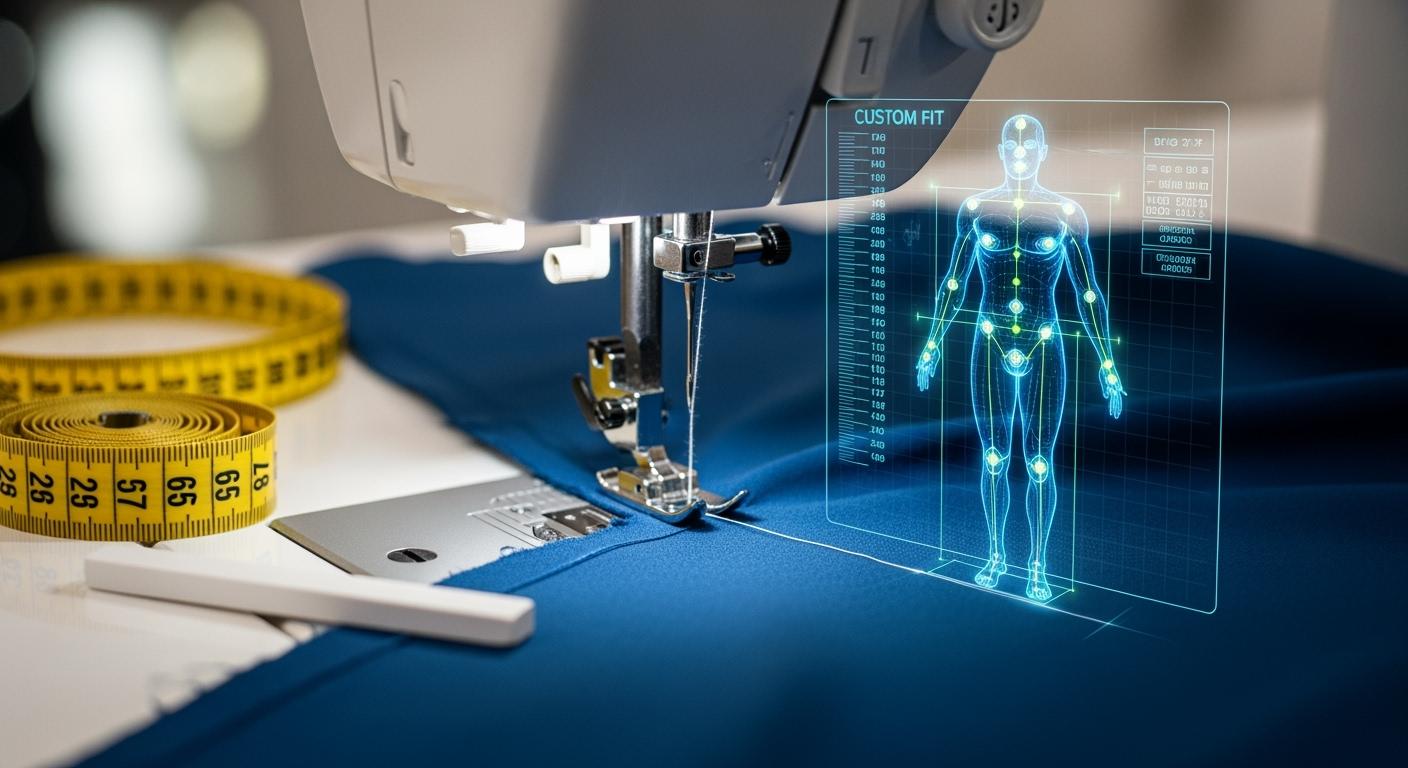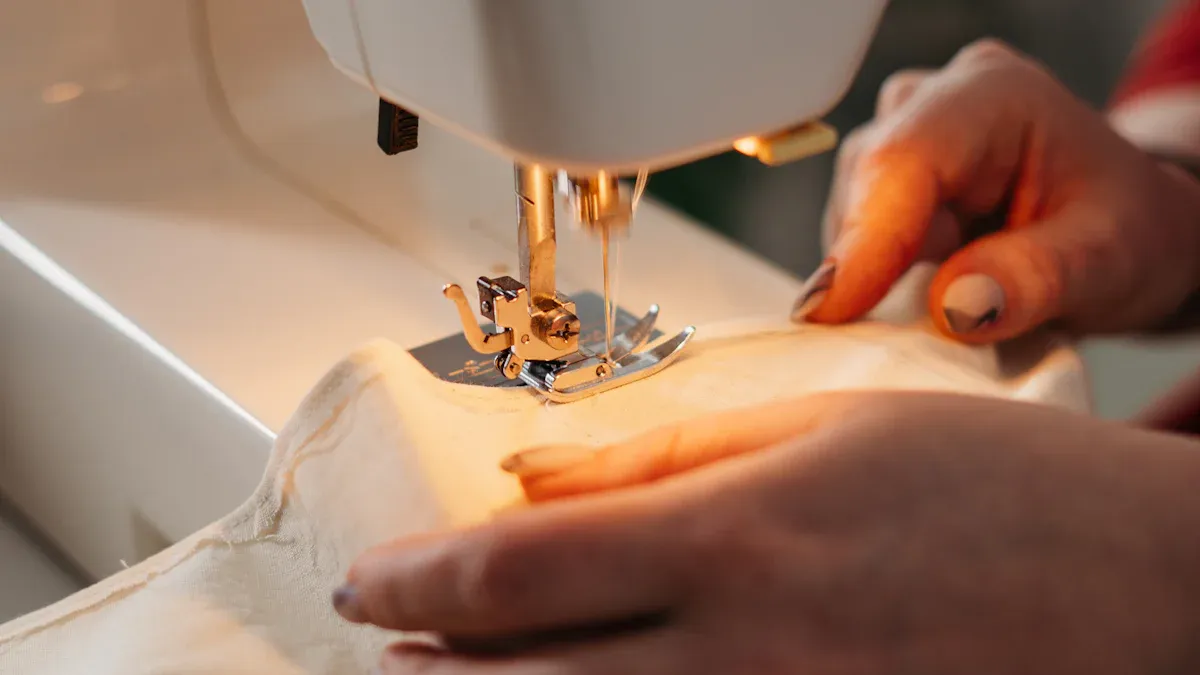
Machine learning is revolutionizing apparel by optimizing seam placement. This innovation analyzes massive datasets on body movement, fabric properties, and ergonomic stress points. It offers a direct solution to long-standing issues of poor fit and discomfort. Poor fit accounts for 70% of clothing returns, highlighting a significant source of consumer dissatisfaction. The industry is rapidly adopting this technology.
💡 Market Growth: The generative ai in fashion market is projected to surge from USD 96.5 million in 2023 to over USD 2.2 billion by 2032, signaling a major industry transformation.
The Problem with Traditional Seams

Traditional garment construction has always struggled to create a perfect fit. The methods used for centuries are now showing their age. They create issues with comfort and fit that modern consumers no longer accept. Before the introduction of machine learning, these problems were difficult to solve.
Limitations of Manual Design
Manual pattern-making has a fundamental flaw. Designers create patterns using Euclidean geometry, which works for flat, two-dimensional shapes. However, the human body is a complex, three-dimensional form with non-Euclidean curves. This mismatch is a primary source of fitting problems. Dr. Mark Liu's research confirms that linear measurements cannot accurately represent the body's true shape.
Two people can have identical chest and waist measurements but possess completely different body structures. One might have a broad chest, while the other has a narrow ribcage. A single pattern fails to provide comfort for both.
This is why traditional methods often fail to account for:
- Individual asymmetries
- Rounded shoulders or a sway back
- Uneven hips or unique postures
Discomfort and Restricted Movement
Poorly placed seams directly impact a wearer's physical experience. In sportswear, this can lead to serious issues that affect performance and comfort. Seams that rub against the skin cause chafing, while those placed over major joints can restrict mobility and limit an athlete's range of motion. Formal wear presents similar challenges. A person with a forward-leaning posture may find their jacket rides up in the back, creating a sloppy look and a constant feeling of discomfort. These fit issues demonstrate a clear need for better design solutions that prioritize wearer comfort.
The Challenge of Mass Production
Mass production makes the fit problem even worse. Brands create clothing based on a single fit model and then scale those measurements up or down to create a size range. This one-size-fits-all approach fails to serve the diversity of real body shapes, leading to widespread dissatisfaction and high return rates. Poor fit is the main reason customers return clothing they buy online. This system is inefficient for businesses and frustrating for consumers who just want clothes that offer a good fit and lasting comfort.
How Machine Learning Powers Smarter Seams

Machine learning transforms garment creation into a precise, data-driven science. The process begins with digital inputs. It ends with a production-ready design optimized for the human body. This system moves fashion beyond guesswork into an era of engineered fit and comfort.
Digitizing the Human Form
The process begins with data. AI models need digital information about the human body to work effectively. Companies create vast anthropometric databases using 3D body scanning technologies. The Biomechanics Institute of Valencia (IBV), for example, holds a database with over 100,000 3D body scans from global populations. This data allows AI to generate accurate digital human models.
These models are far more detailed than simple measurements. They capture the body's unique three-dimensional shapes and curves. The AI uses several types of data to learn:
- Point Clouds: These are detailed 3D maps of the body, capturing precise geometric details.
- Ground-truth Seam Sequences: The AI studies successful seam layouts from existing garments.
- Preference Datasets: Human designers provide feedback, teaching the AI what makes a seam layout good or bad.
This digital foundation gives the AI a deep understanding of human anatomy. It is the essential first step toward creating a better fit and superior comfort.
Predicting Seam Strength
Durability is a key component of a well-made garment. Machine learning models can now predict how strong a seam will be before a single stitch is sewn. This ensures the final product offers lasting comfort and performance.
💡 2024 Research: A recent study highlighted how Artificial Neural Network (ANN) models can accurately predict the seam strength of denim jeans. The AI analyzes fabric properties and simulated stress to forecast durability, improving quality control.
This predictive power is a game-changer. The AI identifies potential weak points in a design. Designers can then reinforce those areas or adjust the seam placement entirely. This proactive approach prevents seam failures, enhances garment longevity, and boosts wearer comfort by ensuring the clothing holds its shape.
Automating Patterns with AI
Once the AI understands the body and material strength, it can generate patterns. AI-assisted pattern design tools take the 3D digital body model and automatically create optimized 2D patterns. This is a major leap from traditional manual drafting. These innovative ai-assisted pattern design tools are revolutionizing the industry.
Platforms like ReelMind.ai, Six Atomic, and Style3D AI are at the forefront of this technology. These ai-assisted pattern design tools translate complex body scan data into perfectly fitted patterns in seconds. The ai-assisted pattern design tools consider both fit and fabric efficiency. For example, the SXD AI platform uses generative algorithms to arrange pattern pieces like a jigsaw puzzle. This method can reduce fabric waste by up to 46%. Many ai-assisted pattern design tools aim for nearly 100% fabric utilization. The use of ai-assisted pattern design tools makes bespoke clothing more accessible. Furthermore, ai-assisted pattern design tools reduce production costs and errors. The automation from ai-assisted pattern design tools ensures every pattern is optimized for both the wearer and the planet. These ai-assisted pattern design tools are key to modern apparel. The efficiency of ai-assisted pattern design tools is unmatched. Finally, ai-assisted pattern design tools deliver superior comfort.
Simulating for Wear Comfort
The final step before production is virtual testing. AI simulates how a garment will feel and perform during real-life activities. This process identifies potential issues like chafing or restricted movement, ensuring ultimate comfort.
AI models use data from photonic smart garments to analyze stress points. These clothes have optical fiber sensors that detect strain during movement. The AI classifies the activity and pinpoints which areas are under the most stress. This gives designers a clear map of where to adjust seams for better comfort.
| Activity | Garment Region Activated |
|---|---|
| Squatting | Abdomen and Arm |
| Up-and-down Arms | Shoulders |
| Walking & Running | Abdomen and Lower Back |
| Sitting | Back, Lower Trunk, and Hip |
To run these simulations, the AI needs specific inputs to predict wear comfort. These include:
- Ease allowance: The extra room needed for movement.
- Psychographic characteristics: The wearer's lifestyle and fashion sense.
- Body measurements: The physical data from the 3D scans.
- Garment pattern measurements: The design specifications of the clothing.
Major brands like North Face and Tommy Hilfiger already use AI to recommend sizes and improve fit. This simulation process guarantees a higher level of comfort and satisfaction before the garment even exists. The focus on comfort is central to this technology. The result is a product engineered for human comfort.
The Benefits of Smarter Seams
The shift to machine learning-driven design offers significant advantages. Garments become more comfortable, visually appealing, and sustainable. This technology creates clothing that truly serves the wearer.
Engineered for Ultimate Comfort
Smarter seams deliver a new level of physical comfort. Predictive models analyze fabric properties and human perception to optimize ergonomics. The AI can forecast how a material will stretch, drape, and feel against the skin. This process eliminates potential chafing points before a garment is ever made.
An AI model like ANFIS combines fuzzy logic with neural networks. It translates subjective feelings, like smoothness, into data. The AI then uses this information to design for ultimate wear comfort.
This data-driven approach ensures every seam placement enhances movement rather than restricting it. The final product is engineered for pure comfort.
Superior Aesthetic Flow
Generative design offers more than just function. It also creates a superior aesthetic style. The AI generates seam lines that follow the body's natural contours. This produces a new, visually pleasing style that looks fluid and modern. Traditional patterns often create awkward breaks in a garment's appearance. AI-driven seams, however, integrate seamlessly into the overall design. The result is a unique style that is both flattering and innovative. The AI helps designers explore a new style of clothing. This new style is very popular.
Hyper-Personalized Fit
AI makes personalized fashion accessible to everyone. Companies like Esenca and TrueToForm use 3D body scan data to create custom-fit clothing. An AI engine analyzes individual measurements to generate a unique pattern. This process allows for on-demand manufacturing of a specific style. The AI considers a customer's purchase history and style preferences. It then recommends a style that fits perfectly. This level of personalization boosts customer satisfaction. It also moves the industry toward a more inclusive model of personalized fashion.
Sustainable by Design
AI-powered design directly supports sustainable fashion. Creating durable, better-fitting garments reduces the need for frequent replacements. This approach minimizes waste and the demand for new resources. When clothes last longer, they can support circular business models like rental and resale. The AI also optimizes patterns to reduce fabric waste during production. This focus on longevity and efficiency is fundamental to a sustainable path for the apparel industry.
The apparel industry is moving from traditional, problematic seams to smarter, AI-driven designs. This transition delivers enhanced comfort, superior aesthetics, and a personalized fit. The future of apparel belongs to AI. AI-driven design is becoming the standard for creating clothing that is not just worn, but experienced. This AI technology allows for deep customization. The AI learns user preferences. The AI adapts to individual forms. This AI innovation ensures every garment is unique. The power of AI is transforming fashion.
FAQ
How does AI improve clothing fit?
AI analyzes 3D body scans and movement data. It then places seams in optimal locations to avoid stress points and improve comfort. This data-driven process creates garments that move with the body, offering a superior fit compared to traditional methods.
Is AI-designed clothing more expensive?
Initially, the technology requires investment. However, AI reduces fabric waste and minimizes costly returns from poor fit. Over time, these efficiencies can make custom-fit and better-designed clothing more accessible and affordable for consumers.
What data does the AI use? 🤖
The AI uses several key inputs. It learns from vast databases of 3D body scans, fabric property tests, and successful seam layouts from existing garments. Human feedback also helps train the models to understand what makes a design both functional and visually appealing.
Will AI replace human fashion designers?
No, AI acts as a powerful tool for designers. It handles complex calculations and pattern generation, freeing up designers to focus on creativity, style, and innovation. The technology enhances human skill rather than replacing it, leading to better-designed apparel.
See Also
Machine Learning: Predicting Fashion Trends to Significantly Boost Your Sales
Revolutionizing Returns: Smarter Fashion AI for Seamless Customer Experiences Today
The Future of Textiles: AI Predictive Maintenance Innovations by 2025
Sustainable Style: Fantastic Fashion AI Solutions for a Greener Planet
Fashion's Future: Leveraging Predictive Models for Retail Success by 2025